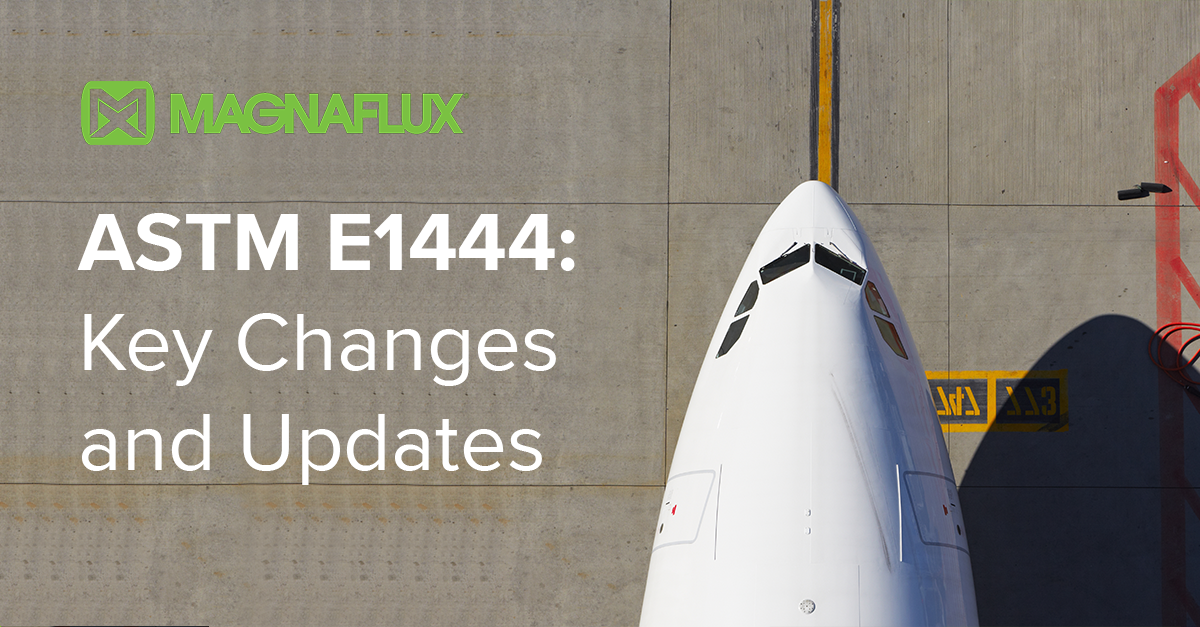
By Shawn Kilty, Division R&D Manager, and David Geis, Product Manager
The next revision of ASTM E1444 is out, and a lot is changing. In total, more than seventy changes and updates are going into effect in this specification. Here are several significant changes you should be aware of.
There are significant differences in how magnetic particle inspection in Aerospace compared to other industries. Beyond just the process checks, there are restrictions on the allowable types of materials and equipment. Rather than trying to accommodate all possible applications with a single standard, the scope of E1444 is changing to focus only on the Aerospace industry. Non-Aerospace users will have to switch over to E3024 Standard Practice for Magnetic Particle Testing for General Industry.
One effect of the Aerospace-only scope change is the removal of all references to visible magnetic particle materials — only wet fluorescent magnetic particles in the latest revision. If your application uses visible color-contrast materials or dry magnetic powders, you will need to change to E3024 as your standard.
With the transition to the Aerospace-only scope, the following accessories and techniques not in E1444:
Handheld yokes, in general, will only be permitted with prior authorization by the Cognizant Engineering Organization (CEO) or Level III. Specialized techniques like magnetic slurries for underwater use, magnetic polymers, tapes, and films are also not included in E1444.
If your application uses any of these materials or techniques, you will need to change to E3024 as your standard.
Table 1 in E1444 spells out all of the required process controls and calibrations and the frequency at which each must occur. All of the changes in this revision involve UV-A lamps. New requirements require checking the intensity of battery-powered lights before and after each use. This ensures that a drop in battery output has not caused the UV intensity to fall below the minimum required levels. The integrity of all UV-A lamps must now be completed daily instead of weekly. It is not specified in Table 1 (instead refer to section 7.4.5), but this revision also requires checking that LED UV-A lamps daily to ensure all diodes are functioning.
It has been over 20 years since the publication of AS-5282 standardizing the Tool Steel Ring for system performance. Since then, AS-5282 rings have had better magnetic performance than the original Ketos rings due to stricter alloy and heat treatment control. To accommodate existing systems and older equipment, the specs for old Ketos rings were maintained in E1444. Starting with the new revision, the Ketos ring will not be carried forward, and only AS-5282 rings will be acceptable.
Formulas used to calculate magnetizing current have been around for ages. They are used in MT training programs and for developing a technique on a new part. But real-world part geometry is not always straightforward, and formulas are just a starting point at best. For Aerospace applications, the Level III is responsible for determining the current necessary for adequate magnetization. That is normally done with sample parts and QQIs, not with calculations. While the formulas are no longer in E1444, they will remain in E3024 and E709 Standard Guide for Magnetic Particle Testing for reference and training purposes.
Inspection of parts before demagnetization is now explicitly required by ASTM E1444. Inspecting parts after demag increases the likelihood of particles migrating away from an indication, potentially leading to missed flaws. Although this is likely self-evident to most MPI practitioners, it was never explicitly called out in prior revisions of E1444.
Magnetic particle baths can become cloudy over time for several reasons. Contamination from lubricants or other machining fluids can turn the bath hazy and will sometimes add a bluish fluorescence to the bath.
A cloudy bath could also be a sign of the particles starting to break down. Bright yellow-green fluorescence observed in the liquid bath after the particles have been allowed to settle is the most common sign of particle breakdown.
E1444 now requires that the liquid portion is evaluated for clarity under visible and UV light after the particle concentration test. If the graduation marks on the pear-shaped centrifuge tube (between the 5 and 25 ml marks) are not visible, then the bath must be discarded.
Published 26 October 2021
Faraday Road, South Dorcan Industrial Estate
Swindon, Wiltshire, SN3 5HE, UK
Telephone: +44 (0)1793 524566
Contact Magnaflux Customer Service
Magnaflux, A Division of ITW Limited VAT number: GB 531 8325 59